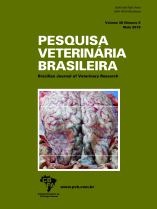 |
|
|
|
Year 2018 - Volume 38, Number 5
|

|
Proteinogram and serum IgG concentration in newborn foals up to thirty days of life treated with plasma, 38(5):795-805
|
ABSTRACT.- Neto C.A.V.C., Oliveira-Filho J.P., Delfiol D.J.Z., Badial P.R., Araújo Júnior J.P., Cruz T.F., Tenório M.S. & Borges A.S. 2018. [Proteinogram and serum IgG concentration in newborn foals up to thirty days of life treated with plasma.] Proteinograma e concentração sérica de IgG em potros, do nascimento aos trinta dias de vida, tratados com plasma. Pesquisa Veterinária Brasileira 38(5):795-805. Departamento de Clínica Veterinária, Faculdade de Medicina Veterinária e Zootecnia, Universidade Estadual Paulista, Campus de Botucatu, Botucatu, SP 18618-970, Brazil. E-mail: asborges@fmvz.unesp.br
The aim of this study was to evaluate serum protein and serum IgG concentrations (after a direct enzyme immunoassay test ELISA optimization) in newborns foals from birth to thirty days of life before and after colostrum consumption and intravenous treatment with plasma. Twenty foals and their respective progenitors as well as four plasma donor’s horses were used. Blood samples were obtained from newborn foals at five time points, immediately after birth and before colostrum intake (M1), ten hours after birth (M2), 24 hours after birth and prior administration of blood plasma (M3), 48 hours after birth and 24 hours after plasma administration (M4), and 30 days after birth (M5). Blood and colostrum samples were collected from the progenitor mares immediately postpartum. Concentration of total protein (TP) and albumin were determined using a biochemical analyzer. The TP concentration was also measured by refractometer. Fractions of total serum protein were separated using agarose gel electrophoresis. Colostrum density was evaluated using BRIX refractometer and specific density colostrometer. Total IgG concentration was determined by an enzyme-linked immunosorbent assay. With the ELISA system proposed here it was possible to determine IgG concentrations in serum, plasma, and equine colostrum samples with adequate repeatability. Serum IgG concentration in foals at birth was 15±8mg/dL (mean ± standard deviation) raising at ten hours (2,408±608mg/dL) and remaining at similar levels up to 48 hours of life (2,364±784mg/dL), and decreasing significantly at 30 days of age (1,414±586mg/dL). Serum and colostrum IgG concentrations of mares were 1,746±505mg/dL and 7,714±2,619mg/dL, respectively. The plasma IgG concentrations from donor mares were 2,026±148mg/dL. Total protein, total globulins, and γ-globulin fraction showed correlation with IgG. Ten hours post birth was an adequate time to verify the transfer of passive immunity, allowing to adoption prophylactic and/or therapeutic measures in a horse farms. One liter of plasma administered at 24 hours of life was not sufficient to raise serum IgG concentrations in foals without passive immunity transfer failure. |
| |
|
|
| |
|
 |